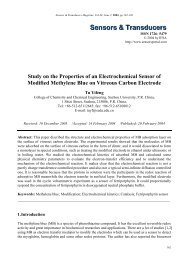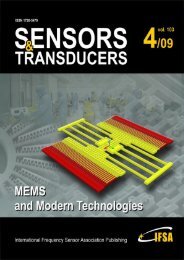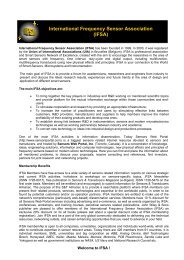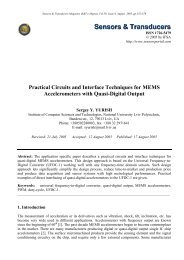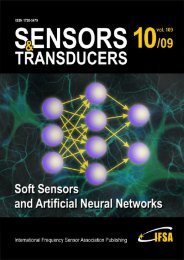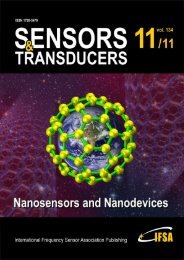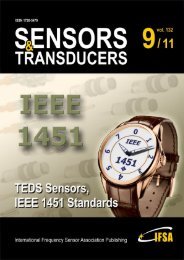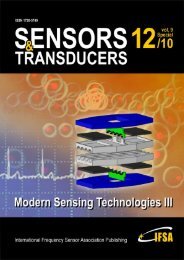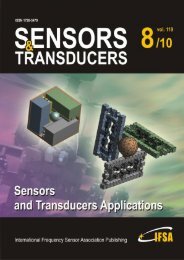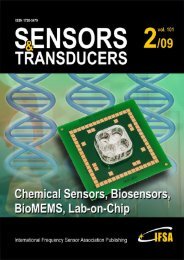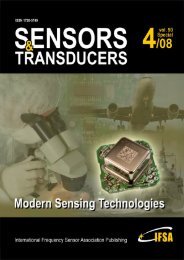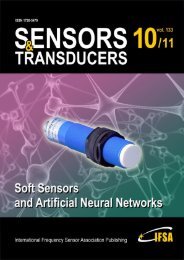Porous Silicon Hydrogen Sensor at Room Temperature
Porous Silicon Hydrogen Sensor at Room Temperature
Porous Silicon Hydrogen Sensor at Room Temperature
You also want an ePaper? Increase the reach of your titles
YUMPU automatically turns print PDFs into web optimized ePapers that Google loves.
<strong>Sensor</strong>s & Transducers Journal, Vol. 103, Issue 4, April 2009, pp. 102-108presence of hydrogen and thus decrease in current. Our results further showed th<strong>at</strong> Pd-Ag/p-Siinterface does not contribute to the enhanced gas sensing but cre<strong>at</strong>e a barrier against current flow. Inreference to our earlier work [18] on Pd modified PS based Pd-Ag/PS/p-Si/Al sensor structure, wherethe response was comparable (84%) but the response time was much faster (~ 8 sec) we can infer th<strong>at</strong>single Schottky junction is good enough for hydrogen sensing.Fig. 6. Band diagram (not in scale) of Pd-Ag/PS junction coupled with a dipole layer during hydrogen sensing.(a) Decrease in metal work function due to the form<strong>at</strong>ion of a dipole layer <strong>at</strong> the interface by the diffusedhydrogen (b) an increase in barrier height <strong>at</strong> the metal / PS junction.5. ConclusionOur experiments with Pd surface modified porous silicon on p-Si substr<strong>at</strong>e in the form of back to backSchottky barrier junctions using Pd-Ag c<strong>at</strong>alytic electrode contacts is useful as room temper<strong>at</strong>urehydrogen sensor with appreciably high response and considerably fast response time. The stability ofthe modified sensor structure is visibly much improved compared to the unmodified one. The sensingmechanism is clarified in respect of hydrogen dipole structure and reduction in metal work functionleading to an increase in barrier height of the junction in presence of hydrogen.Reference[1]. H. Nienhause, H. S. Berg, B. Gergen, A. Majumder, Selective H <strong>at</strong>om sensors using ultra thin Ag/SiSchottky diodes, Appl. Phys. Lett, 74, 1999, pp. 4046-4048.[2]. S. Basu, A. Dutta, <strong>Room</strong> temper<strong>at</strong>ure hydrogen sensors based on ZnO, M<strong>at</strong>erials Chemistry and Physics,47, 1997, pp. 93-96.[3]. S. K Hazra, S. Basu, High sensitivity and fast response hydrogen sensors based on electrochemicallyetched porous titania thin films, Sens. Actu<strong>at</strong>ors, B, Chem, 115, 2006, pp. 403-411.[4]. A. K<strong>at</strong>suki, K. Fukui, H 2 selective gas sensor based on SnO 2 , Sens. Actu<strong>at</strong>ors, B, Chem, 52, 1998,pp. 30-37.[5]. S. E. Lewis, J. R. DeBoer, J. L. Gole, P. J. Hesketh, Sensitive selective and analytical improvements to aporous silicon gas sensor, Sens. Actu<strong>at</strong>ors, B, Chem, 110, 2005, pp. 54-65.[6]. J. Mizsei, Gas sensor applic<strong>at</strong>ions of porous Si layers, Thin Solid Films, 515, 2007, pp. 8310-8315.[7]. S. N. Sharma, R. Banerjee , D. Das, S. Ch<strong>at</strong>topadhyay, A. K. Barua, Control of the crystallite size andpassiv<strong>at</strong>ion of defects in porous silicon by novel method, Appl. Surf. Sci., 182, 2001, pp. 333-337.[8]. Martin-Palma R. J., Perez-Rigueiro J., Guerrero-Lemus R., Moreno J. D., Martinez-Duart J., Ageing ofaluminium electrical contacts to porous silicon, J. Appl. Phys., 85, 1999, pp. 583-586.[9]. Roland Hérino, Nanocomposite m<strong>at</strong>erials from porous silicon, M<strong>at</strong>erial Science and Engineering, B,69- 70, 2000, pp. 70-76.[10]. M. Jeske, J. W. Schultze, M. Thönissen, H. Münder, Electrodeposition of metals into porous silicon, Thinsolid films, 255, 1995, pp. 63-66.107


